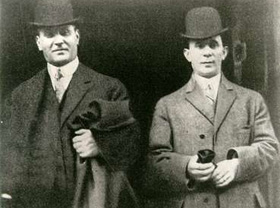Introduction of the Trial Transcripts
Verbatim Witness Testimony
This long-lost record of the criminal trial of Isaac Harris and Max Blanck, owners of the Triangle shirtwaist factory, contains the verbatim testimony of some 100 witnesses. It is by far the most extensive and reliable record of the terrible fire that broke out at the Triangle on Saturday, March 25, 1911, just before closing time.
Voices of Public Officials
In these pages, dozens of survivors give their sworn accounts of the blaze, which killed 146 workers and helped to galvanize workplace reforms across the country. Their testimony is joined by the voices of firefighters and police officers who responded to the scene, of engineers who examined the burned building, and of merchants and customers familiar with the daily routine of the factory. Through these witnesses, the manslaughter trial comes to life. And not just the trial: the fire itself, and the survivors, and the infamous Triangle Waist Company.
Artful Maneuvering By Lawyers
Trials are rarely as dramatic as the events that give rise to them. Much of what happens in court is maneuvering by artful lawyers, with boundaries set by a judge whose job it is to see that the jury is not unfairly provoked by lurid testimony. That is certainly true in this trial, where the defense attorney persuaded the judge to bar descriptions of the most shocking aspect of the Triangle fire: the terrible rain of victims who jumped and fell from factory windows to the sidewalks far below. There is also a recurring note of confusion in the trial, due to the fact that many of the witnesses spoke Yiddish or Italian as their first language.
The Intense and Immediate Testimony of Surivors
Still, in the known record of the Triangle fire, there is little to match the intensity and immediacy of the testimony found here from survivors like Yetta Lubitz, Katie Weiner, Kate Rabinowitz Gartman, Mary Bucelli, Anna Gullo, Eddie Markowitz, Louis Senderman and Louis Brown; from factory owner Isaac Harris and foreman Samuel Bernstein; from elevator operator Joe Zito; from firefighters Oliver Mahoney, Edward Worth and Howard Ruch-and others.
The Prosecuting Attorney
Charles S. Bostwick
The trial was orchestrated by three men. Charles S. Bostwick was the prosecuting attorney. His theory of the case was simple: Locking a factory door during working hours was a misdemeanor, and a misdemeanor that led to a death was felony manslaughter. He set out to prove that Harris and Blanck knowingly ordered an exit door locked on the day of the fire, and that this door prevented the escape of Margaret Schwartz, who died in the blaze. Bostwick wore a brushy moustache and a brooding countenance between his fur-trimmed overcoat and his silk top hat. But his appearance was more dramatic than his performance; the former state assemblyman and professor of corporate law was able, yet colorless, in his conduct of the trial.
For the Defense: Max D. Steuer
Bostwick's opponent was Max D. Steuer, the most celebrated and sought-after attorney in New York during the three decades before his death in 1940. This trial finds Steuer coming into his own, with all the skills that made him famous on display: his photographic memory, his blend of ruthlessness and charm, his devastating cross-examinations. Like many of the Triangle fire victims and witnesses, Steuer was a Jewish immigrant from Eastern Europe; indeed, he worked in a garment sweatshop himself as a boy.
The Controversial Judge
Thomas C.T. Crain is among the most elusive figures in the story of the Triangle fire. Scion of a wealthy New York family, Crain nevertheless owned his career to the mostly working-class political machine known as Tammany Hall. (Steuer was also closely tied to Tammany.) In today's world, Crain probably would not have been allowed to preside, because several years before this trial he, too, had been blamed for a deadly fire. While serving as Tenement House Commissioner in New York City, Crain failed to prevent an apartment house blaze that left 20 people dead. The judge's instructions to the jury at the end of the trial provoked widespread criticism and clearly helped win an acquittal for Harris and Blanck. Still, Crain can also be found in this record taking the prosecution's side in several disputes.
Conclusion
Unfortunately, the full transcript of Vol. 2 of this three-volume record remains lost to history, but much of that second volume was summarized in notes and preserved by an early researcher, author Leon Stein, and is included on the Kheel web site. The transcripts and these notes provide the closest available look at the Triangle fire, how it happened, and how the factory owners escaped responsibility.
-David Von Drehle
Author: Triangle: The Fire That Changed America
August, 10, 2005

